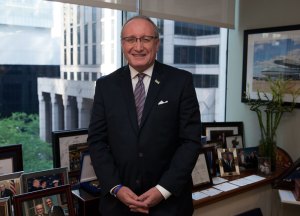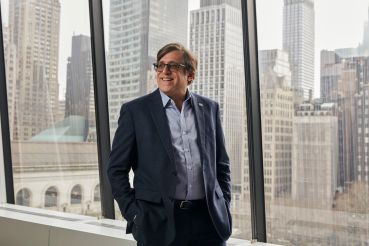Staying Power: Bruce Mosler of Cushman & Wakefield
By Gus Delaporte June 4, 2014 11:00 am
reprints
The list of chief executives who have stayed involved with a company for a significant period of time after leaving the CEO role is a short one. According to consulting firm RHR International, just 50 percent of departing CEOs stay involved with a company as a member of the board, and even then only for an average period of eight months.
Cushman & Wakefield (CWK)’s Bruce Mosler has defied those statistics. The real estate firm’s chairman of global brokerage is still at C&W four years after stepping down as chief executive.

A 15-year veteran of the brokerage business before he transitioned into management, Mr. Mosler admits that even though he returned to a business he knew and loved, he was under no impression the switch would be an easy one.
“It took me a while; it didn’t happen overnight,” he said of his return to the brokerage side. “I won back clients and came up with creative strategies.”
Success has come by way of changing his approach. Today, Mr. Mosler stresses his advisory work, offering advice to major tenants and landlords. He has also surrounded himself with a small group exclusively made up of C&W’s top professionals rather than the large group he worked with in his brokerage days. Now he’s working alongside the likes of Tara Stacom, Josh Kuriloff and Mike Rotchford.
“Working with the very best brokers has allowed me to field the best team for each assignment and to offer the best strategic advice people are seeking,” he said.
Mr. Mosler’s working relationship with Mike Rotchford, an executive vice president in Cushman & Wakefield’s capital markets group, is particularly notable.
He highlights a deal done with the NYU Langone Medical Center at 1 Park Avenue that restructuring the tenant’s lease at the end of 2011. Working with Mr. Rotchford, as well as co-brokers Mr. Kuriloff and Mark Mandell, Mr. Mosler helped NYU Langone expand to nearly 400,000 square feet at the property. The 21-year lease at the Midtown Manhattan office building added 180,476 square feet to the 187,108 square feet currently occupied by the medical center.
More recently, Mr. Mosler and Mr. Kuriloff represented landlord Vornado Realty Trust (VNO) in on of the largest leases of the year: Neuberger Berman’s 20-year, 355,000-square-foot deal at 1290 Avenue of the Americas.
“Vornado had a clear idea of what they wanted in an anchor tenant post-lobby and infrastructure renovation,” he said of the transaction. “The desire to have a very strong tenant that made a statement about how far the building has come as a premiere office building was crucial.”
Going forward, Mr. Mosler will lead the team assigned with leasing up Brookfield (BN) Office Properties’ ambitious Manhattan West development. There, the landlord is redeveloping 5 Manhattan West, previously 450 West 33rd Street, to the tune of $200 million and plans to build two additional towers on the Far West Side.
Demand for space at the large towers is driven by the TAMI (industry parlance for technology, advertising, media and information) sectors. Tech giant Google, with its seemingly insatiable appetite for space, has been rumored as a potential tenant post-redevelopment.
Midtown West, by Mr. Mosler’s estimation, has “taken off” and Manhattan West stands to offer what tech and media tenants crave: large floor plates in new and efficient towers.
“Manhattan West is one of the most exciting opportunities in the city,” Mr. Mosler said. “I think we are in the heart of where certain sectors aspire to be.”
Mr. Mosler prefers to look forward rather than behind, but his stint as C&W’s chief executive cannot be downplayed. To hear him tell it, Mr. Mosler only envisioned a five-year stay at the top of C&W’s management team. In his opinion, it was never meant to last.
“I was pretty clear when I moved into a management role that I saw it as a role to take the firm to the next level, not a permanent role,” he said. “It should be a finite period of time and I believe that that’s true across the board in business. Leaders are meant to be there for a moment in time and I was very clear going in that I thought my time horizon was five years.”
Even short stints have their ups and downs. Between 2005 and 2007, C&W doubled its revenue, a particular highlight for Mr. Mosler. But then the downturn hit and C&W’s headcount fell from 17,000 to 13,000 between 2007 and 2009.
Some press speculation at the time of Mr. Mosler’s departure suggested he left the role of CEO when Exor, C&W’s parent company, lost faith in his abilities. But Mr. Mosler is confident he departed the company in better shape than when he started.
“When I left, the firm was headed in the right direction,” he said.
Looking ahead, Mr. Mosler speaks with tempered optimism about the New York market. He stresses the importance of the TAMI sector as it drives the epicenter of Manhattan’s real estate market to Midtown South, Midtown West and Downtown.
He cautions landlords not to get left behind in the battle to attract the city’s increasingly savvy tenants. “I think to be competitive today, landlords have to be consistently investing in infrastructure or they will find themselves with an asset that doesn’t compete,” he said.
But like any market pro, Mr. Mosler is aware real estate moves in cycles. And while New York has been enjoying a post-downturn boom, the C&W veteran cautions we may be nearer the end of the bull market than the beginning.
“I don’t think we are necessarily at the end but I think we may be more than halfway through,” he said.
On that note, Mr. Mosler concedes that New York remains near the top of the list when large institutions, particularly sovereign wealth funds, look at potential cities to invest in but warns his fellow professionals that they can’t expect the high tide of the current market to go on indefinitely.
“I’m reasonably optimistic but I want to call out that nothing lasts forever,” he said. “I will point out that this is a moment in time when we should be aware that markets move in cycles.”
It’s that perception that will allow Mr. Mosler the ability to offer advice to his big-name clients during the tougher times, when this cycle inevitably ends.
“Everything is rooted in advice,” he said. “I think people are looking for a comprehensive view of what the best approach is and everyone is looking at it from a balance sheet perspective. That is something I am focused on providing.”


